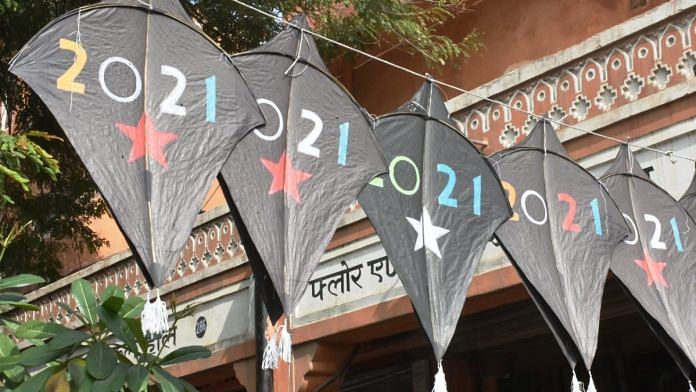Waking up at 4am, even before the break of dawn starts to change the colour of the sky, is an extremely difficult task on any winter morning — except on 14 January.
On the 14th, even before the rooster can clear its throat, many in Jaipur are already rehearsing to yell ‘Woo kata (there it goes down)’ at the top of their voice. The smell of feni, til k laddoo and gajak linger in the air, and songs on stereos playing from the rooftops somehow don’t clash, but complement each other, adding a different vibe to the city altogether.
share with many Jaipur wallas, is the lack of attention the city’s celebration of Sankranti gets when compared to Ahmedabad’s Uttarayan.
Also read: Why ‘AK vs AK’ matters in self-soaked Bollywood
Kai Po Che
At Mumbai’s Girgaon Chowpatty, many gather to fly kites at this rather windy beach (don’t know how they do it) to celebrate the festival.
On one such Makar Sankranti at the Chowpatty, shortly after Rajkummar Rao and Sushant Singh Rajput starrer Kai Po Che was released, I saw many first-timers cheer “Kai Po Che” (a term they picked from the movie, I am sure), every time they thought a kite was brought down.
And that’s where Jaipur’s celebration of the festival loses out to Ahmedabad — the lack of media attention.
Sadly, we don’t have a media savvy Chief Minister entertaining Salman Khan on his rooftop, or organising an international kite flying festival on that day, in Jaipur.
We might have the grandeur, but we lack the willingness to show it off. And so, in people’s imagination, 14 January is a special day in Ahmedabad — Jaipur doesn’t really appear on the list.
Also read: Before desi cow exam, Indians should study how to not kill dolphins and elephants for fun
Kites pull tourists
One good thing that the festival’s ‘advertising and promotion’ does to Ahmedabad is boost the city’s tourist footfall on this day. Many people plan trips to Ahmedabad on Uttarayan, just to be part of the International Kite Flying festival.
The tourism department even organises a ‘heritage Uttarayana’ for foreign tourists to enjoy the festival in its traditional form. Promising a ‘complete experience’ to the tourists, where they’d be able to enjoy chikki udhinyus and fafdas.
Even desi tourists book tickets to enjoy the international festival, with many travel sites offering packages.
This is where Jaipur can draw lessons from.
While Rajasthan tourism does organise some events here and there, we come nowhere close to the grandiose of our neighbours — the Gujaratis. Even the Rajasthan government organises an international kite festival for three days, but put the keyword in Google search, and you’ll know which city the world identifies the kite festival with. (On Google, I got just one search result for the Jaipur festival).
While the Pink City is one of the most popular tourist destinations in India, many keep wondering the best time to visit it. If you ask me, it’d be best to include 14 January in your plan. That’s when it’s neither too hot nor too cold; and what better time to experience Jaipur than on the day it’s celebrating its biggest festival?
Best would be to book a place near or inside the old city from where you can witness the skyline get hijacked by colourful kites in the day and charming lamps at night. You might want to consider a trip to Nahargarh Fort in the evening to see the city release thousands of lanterns into the night sky — for some reason, all Jaipur wallas seem to be doing this in one go.
Also read: Modi era has birthed its own Azadi songs — ‘Bella Ciao, Wapas Jao’ to ‘Kaagaz Nahi Dikhayenge’
…but kill people too
All festivals must be celebrated with caution. Many people injure themselves seriously on Sankranti. Some even die while flying a kite or looting a ‘kati patang‘. Disturbing reports of two-wheeler riders accidently slitting their throats with manjas that lie unattended fill the newspapers the day after the festival. Birds too are killed or injured as they get entangled in such manjas.
One must strive to celebrate a responsible Sankranti. Don’t buy manjas — they’re dangerous and non-biodegradable.
Views are personal.




Exactly what i have felt all these years for Jaipur’s Sankranti and Diwali celebrations, they are amongst the best in India, though not covered well barring local media.Maybe we do need something like JLF for our festivities.